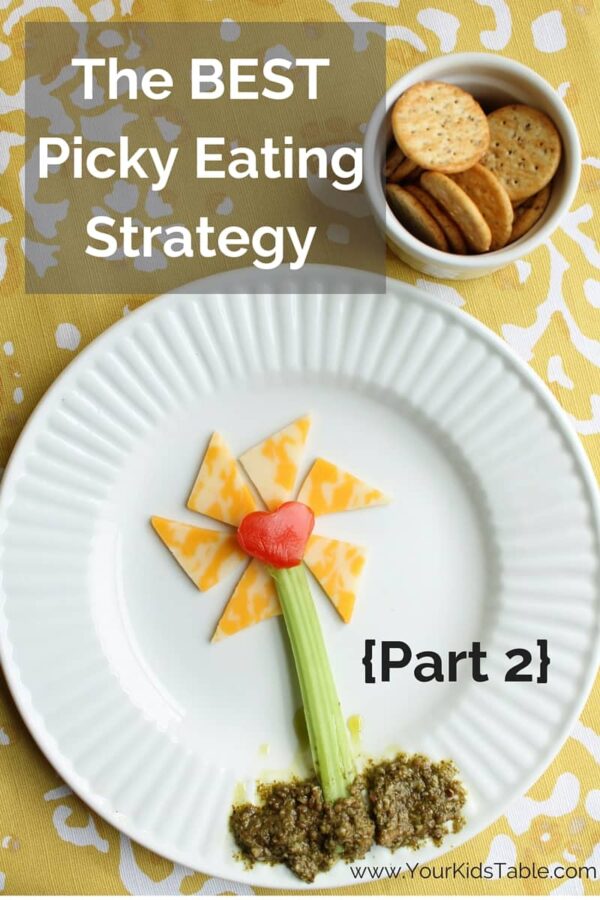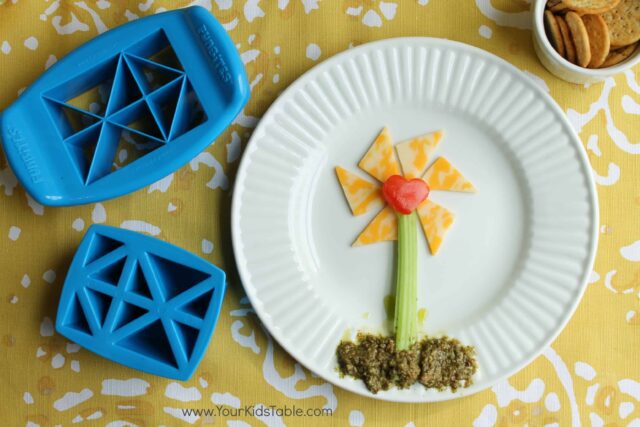This post is sponsored by FunBites.
A few weeks ago I published a post about the best picky eating strategy I can give you, to not pressure your kid to actually eat. If you missed that, head over there first and then come on back! I knew it was going to be a hot button issue, but even I was surprised at the response. So, thank you for your patience, many of you have been asking for details on how to actually make the no-pressure meal time work in your home. I am back today with specific guidelines and solutions to really help you put the no-pressure tactic into effect so that you can watch the, often amazing, results unfold. As a pediatric OT and mom that practices this picky eating strategy, I really do believe it is the BEST solution in most instances.
Since there were so many questions on facebook and in the comments of the last post, I want to answer them all here, Q and A style. This should cover all those burning questions, but if I missed anything or you need more clarification, please leave a comment. I love hearing from you guys and your comments really help each other. Having a child that is an extreme picky eater often feels very isolating. Of course, I know how many kids and their families are struggling, but many reading don’t know that. Your story or questions will likely help someone else, so please feel free to share! Also, as I said in the last post, I know some of you may have strong feelings against this approach. I completely welcome constructive comments, but please refrain from negative or rude comments.
Before we get into the questions, I have to give a BIG thanks to our wonderful sponsor, FunBites. They have been a generous supporter of Your Kid’s Table and help keep the content coming to parents and professionals that need it. My kids and I love FunBites because they cut everything neatly,and quickly into fun shapes that are really motivating for the kids. Picky eaters respond really well to uniform shapes, and setting up pictures or scenes gets them interacting with (and even eating) foods they may have refused in the past. See the end of the post for a coupon code.
Let’s get to the questions…
1. Okay, so, I just put the food in front of her, what if she ignores it or refuses?
Here’s the thing, although I’m suggesting that you don’t pressure your child to eat, I am not saying that means that meal time is a free for all. In fact, quite the opposite. The last thing I would want is for your child to eat when, where, and what they want. Deciding those terms is the job of the parent. The child’s job is to decide if they are going to eat it or not.
In my eating basics tab, I run through all of the important elements to having an important structure and routine, but I want to run through some of them quickly here, too. Not pressuring your child to eat doesn’t work too well without mealtime structure. As the parent, you must determine what is being served for the meal, ensuring at least one preferred food is available. If your child comes to the table and sees a plate of lasagna (which they have never eaten) it really isn’t fair to just say, “Your choice if you eat or not.” But, if you serve that lasagna with some bread (which they love) and maybe a side of fruit, then it is totally fair.
It is also critically important that your child is on a schedule. They should eat every 2.5-3 hours with nothing in between but water. If they have access to food whenever they want it, they will not eat anyways.
Eating at a table, and ideally eating together, will have a big impact on their success at meals. Grazing and eating in front of the TV regularly, also sabotage this strategy.
If you are able to put this structure in place and they then refuse to eat, then, yes, you allow that. Honestly, there isn’t much you can do about it anyways, but spin your wheels, cause major anxiety, and power struggles.
2. What if my feeding therapist gave me the opposite advice? I’ve been using a behavioral approach, should I stop doing that?
While it is becoming less popular, it is true that many therapists use a behavioral approach (i.e. take a bite of this and then you can have this candy/video/preferred food). I can appreciate the value in this approach and some families feel this is the right approach for their child, I totally respect that. These posts are not meant to shame or guilt you into a different approach. If you have concerns, discuss them with your therapist, leave a comment here, or consider seeking out other opinions.
3. At what age can you start implementing this? My toddler isn’t going to understand.
This concept can be difficult with young toddlers, and I think there is some leeway, but you’ll want to refer back to that structure I discussed in question 1. That all applies for them too, and in some ways it is even more important. Keep in mind that toddlers are notoriously inconsistent eaters, this comes with the territory. Your job is not to freak out (I know easier said than done) and trust that they are following their internal cues. By the time your child is 18 months to 2 years old, you should be able to totally follow this approach completely without having to maybe grab something extra part-way into the meal if they aren’t eating.
4. What is the difference with praise and pressuring?
In the last post, I quickly ran through some example of how we pressure kids to eat. One of those ways is through praise. This often surprises parents the most, and I didn’t have time to get into it in the last post, so I’ll elaborate here. Research shows us that kids usually feel pressured when they are praised because it is either putting the spotlight on them which most kids don’t like, or it’s setting an expectation that they have a hard time living up to. If you really want to acknowledge what you child has done, try to wait to end of the meal and make a comment in passing. Although we want to give them the praise, they actually don’t need it when it comes to eating. Instead, we want to teach them to be intrinsically motivated.
5. My gut is telling me this is the way to go, but I’m scared, what if my son doesn’t eat anything?
This is a valid point, and there are some instances when this is a genuine concern, and in these cases the child should be in the care of a team with a specific feeding plan in place. If your child is growing on a curve, then they are probably eating enough. We tend to over analyze what our kids eat, and their caloric needs are significantly less than ours. It can be hard to let go of the control or worry, but I encourage families to try this for a month and see what the results are.
6. Do I keep giving them more of the preferred food or do I tell them they need to eat more of their other foods first?
Ellyn Satter would say yes, give them as much preferred food as they want, and that would be truly following the Division of Responsibility. I know this is hard for a lot of parents, and I personally feel there is some gray area here, but parents need to tread very cautiously because putting any restrictions on food is a quick slip into pressuring. With my oldest, that doesn’t have any eating issues, and eats a wide variety, I will occasionally give a prompt for him to eat some more of his food before he just has more bread. I know he eats these foods, I don’t give a specific quantity or make a big deal about it. I’m also careful to not turn this into a reward, but technically I am pressuring a bit. However, I don’t get into power struggles over this or monitor his intake closely. At the same time, if he or my selective eating child have things on their plate they don’t typically eat, I don’t make the comment. I will use other strategies like, changing up the food they are refusing by cutting it into a different size or shape or by giving a dip.
7. Does the no pressure apply to eating desirable quantities of food in general, especially if my son only eats a small amount?
Yes! Building on what I just said there is a bit of wiggle room, but you’ll definitely want to avoid specific quantity suggestions, bartering, etc.
Please know that I totally appreciate how difficult making these changes may be and the daily struggle it is living with a child that has a limited diet. It is overwhelming, exhausting, and parents tend to unnecessarily blame themselves. Join Your Kid’s Table email subscription to keep the support coming. You aren’t alone! See the sign up box in the sidebar so you have the latest post in your inbox, not missing a thing. I only post a few times a month, so I won’t be flooding your inbox.
Don’t forget to thank our sponsor, FunBites, by heading over to check out their fun cutters – perfect for Easter baskets.





I’d like to mention seeing why they don’t like/want something. I remember telling my dad that mango tasted fuzzy and dad telling me I was weird. He still tried to get me to eat it but thankfully gave up eventually. As an adult I realized I’m actually allergic to mango but didn’t have the words/knowledge to say so. I’m also lactose intolerant and milk made my stomach hurt, dad thinks milk makes everyone’s stomach hurt because he’s lactose intolerant as well. Sometimes picky kids are picky but sometimes they’re allergic or intolerant.
Hey Angel,
Absolutely! Being aware of the possibility of intolerances and allergies is so important. Thanks for sharing your experience!
Best,
Andrea
Hi! I started following these guidelines and routine and just wondering what If my boys (3&4) always only eats the preferred food so they’re a lot of times hangry which is pretty stressful for me also have a 6 month old with kids who are just not as happy as usual… is this the goal to get them to eat more by them just always being hungry??? And also should the preferred food be a very filling one I’ve been doing just fruit but can it be their usual “entree” which for my boys is peanut butter toast??? Thanks!!!
Hi Jessica,
We’re so glad you’re here! Yes, the preferred food can be a more filling. Sometimes it can also be helpful to start off with two preferred foods and one new food, then work your way up to only one preferred food. You might want to check out our free picky eating workshop. It’s a great place to start! Save your seat HERE.
Best,
Andrea
Just as a quick follow up, what do you do if your child eats all his preferred food at a meal and says he’s still hungry but doesn’t want the other food at the table? What is the best response? Thank you!
I apologize if you’ve already covered this info. I have an almost 12 year old and a 9.5 year old. My older is a very picky eater. While he’s always been picky, his pallet has continued to shrink over the years. There are definitely suggestions here and in your last post we can put into practice. One concern that often leads us to cave on some things or pressure him is that he has some challenges that can be exacerbated by hunger. Anyhow, is it better to plate their food for them or just put the options on the table and let them serve themselves what they want to eat and how much? Is it okay to cut them off on a preferred item if they have eaten their portion? For example, there are 8 dinner rolls available, enough for each person to have 2. Is it okay to cut him off after 2 until the end of the meal and he can have any leftovers that happen to still be uneaten? Finally, my kids (usually my younger one who has some picky eating but maintains a pretty broad pallet of foods) will eat everything I serve them and, instead of asking for 2nds will ask to have something different that is not on the menu, like fruit or yogurt. Is this something to allow? Thanks for your help!
Hi Eve,
We are so glad you’re here! Picky eating can be really tricky. You might try always having 1 preferred food as an option along with whatever else you are serving. It’s ok to cut off the preferred food after your child has eaten the amount allotted for him. You might find it easier in the long run not to allow different foods that aren’t on the menu (as long as you are providing at least 1 preferred food!). You might check out our post on food jags, at the bottom you can find some ideas of how to expand foods! I hope that helps!
Best,
Andrea